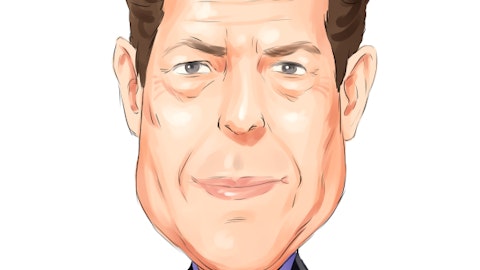Rite Aid Corporation (NYSE:RAD) Q4 2023 Earnings Call Transcript April 20, 2023
Rite Aid Corporation misses on earnings expectations. Reported EPS is $-1.24 EPS, expectations were $-0.77.
Operator Good morning. My name is Rob, and I will be your conference operator today. At this time, I’d like to welcome everyone to the Rite Aid Corporation Fourth Quarter Fiscal Year 2023 Earnings Conference Call. All lines have been placed on mute to prevent any background noise. After the speaker’s remarks, there will be a question-and-answer session. [Operator Instructions] Thank you.Byron Purcell, Vice President, Investor Relations and Treasurer, you may begin your conference.Byron Purcell Thank you, Rob, and good morning, everyone. We welcome you to our fiscal 2023 fourth quarter earnings call.Elizabeth “Busy” Burr, Interim Chief Executive Officer; and Matt Schroeder, Executive Vice President and Chief Financial Officer, will begin the call with prepared remarks.
Chris DuPaul, Chief Operating Officer of Elixir, will also join the call during the question-and-answer session.As we mentioned in our release, we’re providing slides related to the materials we’ll be discussing today. These slides are provided on our website, investors.riteaid.com. While management will not be speaking directly to these slides, these slides are meant to facilitate your review of the company’s financial results and to be used as a reference document following the call.Before we start, I’d like to remind you that today’s conference call includes certain forward-looking statements. These forward-looking statements are presented in the context of certain risks and uncertainties that can cause actual results to differ. These risks and uncertainties are described in our press release in Item 1A of our most recent annual report on Form 10-K and in other documents we will file or furnish to the SEC.Also, we’ll be using certain non-GAAP measures in our release and in the accompanying slides.
The definition of the non-GAAP measures, along with the reconciliation to the related GAAP measures, are described in our press release and the slides.And with that, let me turn it over to Busy.Elizabeth “Busy” Burr Welcome, everyone, and thank you for joining our Q4 earnings call.I realized that this is the first time that many of you are hearing from me as the Rite Aid Interim CEO appointed by the Board on January 9. I’m thankful to the Board for choosing me to manage the business during a critical time when urgency and focus is needed and happy to serve until such time as a permanent CEO is hired. As a Board member for the last three years, this assignment is especially important to me. I’m singularly focused on making progress and ensuring we do not lose any time while conducting our search for a permanent CEO.Rite Aid, as you know, with the longstanding trusted U.S. brand in the retail pharmacy space, [as is] (ph) Elixir in the PBM space, we’ve been a highly leveraged company for many years, which has limited our ability to invest in the business and keep up with our competitors.
Before I share more on what we are doing to return our business to growth, I’ll briefly cover Q4.Q4 adjusted EBITDA of $129 million was above the midpoint of our guidance and better than analyst expectations of $101 million and prior year Q4 of $106 million. The main drivers were: front-end sales comps, excluding cigarettes and tobacco products, of 2.8%; SG&A improvements from cost reductions initiatives and store closures; and script comp of 5.2% or 9.7% excluding COVID, demonstrating share gains over the last five quarters for a total of 50 basis points to 11.2%, according to IQVIA.As pleased as we are about Q4, our focus is on the future and what lies ahead. We anticipate many headwinds for fiscal year ’24, none of which are a surprise, but we need to plan for them.
As in the past several years, we expect reimbursement rates to be under pressure, cycling COVID benefits to add to the challenge, and wage inflation and shrink to eat into earnings. We’ve also lost ground in the PBM market from a loss of a large health plan account, and the plan shrinking of our Med D business.I know that litigation faced by us and many others in the industry is on your minds. We are actively managing those matters and defending ourselves. We’ve engaged excellent legal counsel and the anticipated cost to defend ourselves is factored into our guidance. But as you all know, litigation is a process that takes time.That being said, there are great opportunities for us to be very successful. There is a fundamental consumer need for pharmacy services, for both individuals and companies.
At Rite Aid, we serve these needs through both our retail and PBM businesses, respectively. We have a trusted and iconic brand and attractive retail footprint and a long history of serving millions of customers built over the years largely through our pharmacists.Specifically, the role of the pharmacist has become an increasingly important, trusted, ubiquitous, and efficient option for the delivery of healthcare services to consumers. And this is part of our core value proposition. We augment this with digital and remote capabilities to support customers in their preferred channels.We have a lot of work to do to seize the opportunity given the pressures I mentioned. There’s a sense of urgency that the Board and I have brought to Rite Aid. Simply put, we need to grow the core, prescriptions and retail, and grow the PBM, all while continuing to make the company more efficient.

flocu/Shutterstock.com
We will not be chasing long shots, but rather we are immediately focusing on the core areas of our business with initiatives that have high- and nearer-term ROIs. We also need to do this while carefully managing our capital structure.On a macro level, last fall, Rite Aid started the implementation as an established turnaround model that has been used at numerous companies to successfully turnaround their business. While you’ve heard the term turnaround used before, this is different. We are partnering with a leading consulting firm that has worked with several Fortune 150 companies to execute a highly prescriptive and programmatic model, that has a rapid cadence and analytical rigor, and currently engages associates from across the Rite Aid enterprise.
We believe that this model, that is geared to drive performance and acceleration across the enterprise, will enable us to organize effectively and efficiently to capture value and drive growth.I am also well aware we need to prove it. It begins with leadership. And as you have seen, we are not afraid to make changes and significant ones as needed. To execute our turnaround, we have both eliminated some position at up level talent and capabilities by adding new positions and bringing in new perspectives. In addition to a new CEO, we’ve added a new Head of marketing, a new Head of Merchandising, a new Head of Procurement, a new Head of Transformation and a new Head of FP&A to bring in new discipline and expertise to our operations and business.The turnaround model has given us visibility to the profitability opportunities we believe we’ll drive; we can drive over the next three years by focusing on improvements and growth in our core businesses.
Many of the opportunities are simply catching up to things our peers do better than us today. We believe this effort will position the core business for growth longer term. Here are a few examples of turnaround initiatives in the three core areas of the business.In our pharmacy business, we’re continuing to invest in med adherence. For example, we’ve seen a nearly 150 basis point increase in adherence from our Courtesy Refill Program. From industry benchmarking, we believe continued investment in this program has the potential to bring significant upside. We are scaling a successful Q4 pilot initiative that produced a 60 basis point reduction in abandoned scripts to enhance message timing and content. At scale, just 1% improvement could drive a material impact on adjusted EBITDA.In the front-end, we’re optimizing inventory to improve our in-store experience and increase working capital.
Initiatives include space productivity efforts and replacing categories that are over-spaced with faster growing categories. We are able to reduce inventory by $40 million in fiscal year ’23 and we will be deploying further inventory controls this year. We’re implementing a store clustering initiative to enable regional assortments and improve our product relevancy based on the success of the regionally focused product assortment [indiscernible]. We’re improving our pricing analytics and capabilities by increasing the number of price zones and creating a variable price zone structure. We began to realize gross margin benefits from the initial pricing tests.In Elixir, we’re continuing to focus on client retention through things like improved reporting and pricing competitiveness.
We have already secured three of our top five renewals. We’re continuing our efforts to improve procurement economics, specifically through contributions from plan design administration, formulary and rebate management services and network performance. We’re taking steps to optimize our specialty and mail pharmacies with expanded access to networks and new limited distribution drugs. We’ve already gained access to two of the four largest Medicare networks.Last year — lastly, we’re working on efficiency, productivity and, of course, cost reductions across the business. Examples include: rebuilding our indirect buying process and renegotiating better contracts; tackling and reducing our lease burden through extensive lease renegotiations; driving down prescription brand inventory by implementing new controls and deploying just in time ordering models.
This is just a small selection of the initiatives in our turnaround program.So, what does this mean for financial performance? In fiscal year ’24, this means it’s down or reset year in profitability. We expect to see positive improvements in prescriptions in retail and cost savings, but these could be more than offset by the pressures I mentioned earlier in reimbursement rates, lower COVID benefits, the loss of the Elixir lives, a shrink wage inflation, and the investments we need to make in the turnaround program.We estimate the net result to be an adjusted EBITDA dropping by approximately $75 million, which may put free cash flow slightly negative for the year. However, we have $1.5 billion in liquidity at the end of fiscal year ’23, which we believe is more than enough to get us through fiscal ’24.
And we expect increased adjusted EBITDA and working capital benefits in fiscal year ’25 and ’26 to drive an improvement in our liquidity position.In the fourth quarter of fiscal year ’23, we started the first phase of initiatives of our turnaround program. These delivered approximately $10 million in adjusted EBITDA. And our turnaround program is not yet at scale, and we have more initiatives in progress. The turnaround model anticipates bringing more significant value starting in Q3 and Q4 of this year. We are targeting adjusted EBITDA double-digit percentage growth in fiscal year ’25 and ’26 as initiatives begin to scale.Acquired investments are no longer needed to offset the improvements and we’re no longer cycling COVID headwinds. We anticipate some slippage on our near-term leverage ratio.
We do, however, believe that by year-end fiscal ’26, our leverage ratio will come down into the low 5 range, with improvements in adjusted EBITDA. We are also in the process of developing specific plans to address our ’25 and ’26 bond maturities, more to come as these plans develop.I know it has been challenging for you all as the company has faced the uncertainties of COVID and lackluster financial results. We have not until now applied an analytical, programmatic approach to turning the business around. What I commit to you is this, we have urgency, rigor, a rapid cadence and an intense focus on those opportunities that we believe will bring us value in the near term. There are areas that have presented opportunity, but have not been prioritized previously.
There are things that our competitors do well that we just simply have not implemented until now.We appreciate all support from our bondholders, shareholders, analysts, associates, customers and leaders as we take this incredible brand and bring it back to where it should be.With that, I’ll turn the call over to Matt with more Q4 — with more Q4 and on our outlook.Matt Schroeder Thanks, Busy, and good morning, everyone. I’m going to take just a few minutes to review our fourth quarter results before jumping into the guidance for fiscal 2024.Our fourth quarter fiscal ’23 adjusted EBITDA was $128.6 million versus $106.1 million for last year’s fourth quarter, giving a total adjusted EBITDA of $429.2 million for the fiscal year. Both our fourth quarter and full year results benefited from an extra week in fiscal 2023, which contributed approximately $10 million in adjusted EBITDA.The company also reported a net loss of $241.3 million or $4.39 per share and adjusted net loss of $68.2 million or $1.24 loss per share.
Included in our net loss for the fourth quarter was an impairment charge for goodwill at Elixir of $119 million.We performed an impairment assessment as part of our year-end closing procedures. The calculation performed to determine if an impairment is necessary includes evaluation based upon discounted cash flows as well as an assessment of market value. Our projections for the business have not changed since our last assessment, but assumptions around external factors such as discount rates and market multiples [have] (ph), which caused the impairment charge. As a reminder, this is a non-cash charge.Revenues for the quarter were $6.09 billion, bringing our total year revenues to $24.1 billion.Now, I’ll discuss the key drivers of operating results in our business segments.
In the retail segments, revenues increased 8.2% over the prior year, driven by the extra week, an increase in comparable store sales, partially offset by the impact of the store closures.Same-store sales for the fourth quarter increased 8.9% over the prior-year period, consisting of an 11.4% increase in pharmacy sales and a 2.3% increase in front-end sales. Front-end same-store sales, excluding cigarettes and tobacco products, increased 2.8%, driven by strong results in our beauty, seasonal and consumable categories.The same-store prescription adjusted to 30 days increased 5.2% and, excluding COVID immunizations and testing, increased 9.7%, with same-store maintenance prescriptions increasing 8.2% and other same-store acute prescriptions increasing almost 15%.
Our script growth comes from continuing adherence initiatives, growth within our market access contracts and capturing fair share of our scripts from the ESI-Kroger dispute.Rite Aid’s front-end margin rate improved due to a reduction in markdowns resulting from our previously discussed change to our loyalty program, as well as improved planning around seasonal, less discounted prices and proactive price changes related to inflation.Pharmacy gross profit declined due to a reduction of gross profit from COVID vaccines and testing. This was partially offset by our strong non-COVID script growth and reduced drug purchasing cost, driven by a reduction in brand prescription inventory.Adjusted EBITDA SG&A improved by $75 million on a comparable 13-week basis, driven by: a reduction in work payroll, we continued good expense control in stores which we began at the beginning of the fiscal year; reductions in indirect spend, including advertising, repair and maintenance, supplies and security, resulting from initiatives to improve our spend control discipline and rebidding processes; and also driven by lower occupancy due to store closures.I’ll now shift to our Pharmacy Services segment, Elixir.
Revenues were $1.3 billion for the quarter, a decrease of 20.8% compared to the prior quarter. For the fiscal year, Pharmacy Service segment revenues were $6.5 billion, a decrease of 10.9% compared to the prior year. Revenues decreased as we are cycling through our membership losses, which are consistent with our expectations. In our individual Part D insured business, we continue to adjust our pricing strategy to reflect the underlying risks in each geography.Adjusted EBITDA was $27.3 million compared to — for fourth quarter compared to last year’s fourth quarter adjusted EBITDA of $3.7 million. For the fiscal year, adjusted EBITDA was $141.1 million compared to prior-year adjusted EBITDA of $113.3 million.Gross profits were better due to improved procurement economics, a more favorable mix to higher margin business, the absence of prior-year rebate receivable write-downs and improvements in the medical loss ratio at Elixir insurance.
Additionally, Elixir’s SG&A improved due to reductions in cost structure to support the lower membership base.I’ll now turn to our cash flows and the balance sheet. Our cash flow statement for the quarter shows operating cash of $266 million due to the sale of the remainder of our calendar 2022 CMS receivable and reductions in inventory levels, offset by timing and other liabilities. Cash used in investing activities was $14.2 million for the quarter. We completed a few store sale leaseback transactions that generated total proceeds of $17.5 million, and also generated proceeds of $18.6 million from the sale of prescription files from closed stores.Our net debt was approximately $2.8 billion at the end of fiscal year, with a leverage ratio of 6.5 times.
We ended the fiscal year with approximately $1.5 billion in liquidity, which gives us plenty of flexibility to execute our turnaround.During the quarter, we completed a tender offer for $165 million of our 2025 notes. Over the past year, we have reduced the amount of our outstanding 2025 notes, which is our nearest term maturity from $600 million to $320 million. We are assessing options to address the remainder of these maturities, more to come as we progress throughout the year.Now turning to guidance. As Busy outlined earlier in the call, we are investing in a proven turnaround model to drive growth and value for our stakeholders. Adjusted EBITDA is expected to be between $340 million and $370 million. Adjusted EBITDA in the Retail Pharmacy segment is expected to be between $240 million and $260 million, while adjusted EBITDA at Elixir is expected to be between $110 — $100 million and $110 million.Following are some key assumptions in preparing our guidance range.
We expect COVID vaccines and testing demand to decline, with our COVID vaccine administration to decline from about 5.1 million in fiscal 2023 to approximately 3 million in fiscal 2024. However, we expect to see continued growth in comp sales and scripts in our core business. We expect the script growth initiatives that Busy outlined earlier this year to drive a 6% increase in non-COVID comparable scripts in fiscal 2024. While it’s very early in the year, we are seeing this level of increase so far. The benefits from script increases will be partially offset by reimbursement rate pressures.With wage pressures and cost inflation as well as investments that we’re making in our turnaround initiatives, we expect our retail SG&A to increase during the fiscal year.
However, we expect these increases to be partially offset by a rigorous demand management, rebidding a key indirect vendor services and active negotiations of lease terms.Included in our guidance for Elixir is the cycling of the full impact of the loss of lives over the past few years, which resulted in a headwind to adjusted EBITDA. With the reduction of lives, we will continue to closely manage our expense levels. We also expect to improve Elixir EBITDA margin through procurement economics and favorable membership mix.Total revenues are expected to be between $21.7 billion and $22.1 billion. The reduction from prior year is due to the impact of store closures and the reduction of lives at Elixir.Capital expenditures are expected to be approximately $225 million.
In addition to regular maintenance spend, this includes investments to grow our digital business, improve our member support systems and client service at Elixir, add technology to make our distribution centers more productive and to aggressively pursue prescription file purchases. Cash interest expense is projected to be approximately $250 million.We expect to generate a significant working capital benefit in fiscal 2024 from reductions in prescription brand inventory, SKU rationalization and reductions in seasonal merchandise. We’re also taking steps to move more of our products to scan-based trading and to work with various partners to improve terms. As Busy said, we expect our free cash flow to be slightly negative, which will leave us a strong liquidity throughout the year.
We have the ability to reduce spending on capital expenditures if need be.The initiatives that are intended to drive significant value in our turnaround process will take time to take traction — gain traction. As a result, we expect to generate between 60% and 70% of our adjusted EBITDA in the back half of the year.As we look to our fiscal ’25 and fiscal ’26, we expect to grow both Elixir PBM membership in our core retail business in both front-end and pharmacy. Although adjusted EBITDA will take a step down in fiscal ’24, we believe our programmatic approach is turning around the business. Combined with the absence of COVID-related headwind in 2025 and a reduction in turnaround investments, will enable us to grow adjusted EBITDA by double digits in both fiscal ’25 and ’26.
We expect this growth to lead to a reduction in our leverage ratio to somewhere in the low 5 times range by the end of fiscal 2026.This completes our prepared remarks. Rob, could you please open the phone lines for questions?
See also 21 Largest Stock Exchanges in the World and 11 Best Counter Cyclical Stocks To Buy Now.
Question-and-Answer Session Operator [Operator Instructions]
And your first question comes from the line of Elizabeth Anderson from Evercore ISI. Your line is open.Elizabeth Anderson Hi, guys. Thanks so much for the question. I have a couple of sort of housekeeping questions to help understand better the core profitability improvement in the fourth quarter, and then maybe after — other one after that.If we think about — thanks for the update on the COVID contribution. Can you just run through sort of, like, the PCR, OTC test, and flu shots just in the quarter just so that we can get a better idea for the run rate underlying profitability of the core business and that improvement sequentially, please?Matt Schroeder Sure, Elizabeth.
Good morning. So, we did about — we administer about 600,000 COVID vaccines in the fourth quarter, met about 500,000 flu shots. And on the PCR testing, pretty much nothing. PCR testing demand is completely dried up. Antigen test, we sold about 3.5 million of antigen tests during the quarter.Elizabeth Anderson Okay. Super helpful. Any changes to how you think about the profitability of those types of items in the vaccines once the PHE ends?Matt Schroeder Yeah, the change is going to — it’s not necessarily related to the PHE, Elizabeth, but what we expect to happen for the majority of vaccines — COVID vaccines we fill in fiscal ’24 is that we’ll move to a model where we purchase the vaccines from manufacturers and [indiscernible] a reimbursement remodel that’s based upon kind of funding those purchase vaccines.
So think of the gross profit per vaccine next year to be a lot more like a flu shot as opposed to getting a dispensing fee from the government, which is how it’s worked the last couple of years.Elizabeth Anderson Okay. That’s very helpful. And then, I think you sort of talked about it at a high level. But I wanted to just dig in a little bit more into what you and Busy were saying about the mid-single digit non-COVID comparable prescription growth. Can you talk about sort of the initiatives and where you think those will come through? Because that — I mean, that’s obviously a key part of the thesis. So, I just want to make sure we have that down correctly.Matt Schroeder Yes. So, if you think about kind of the drivers outside of COVID, it’s really focused on a few things.
One is working on continued efforts to improve our adherence. We expanded courtesy refill this year, which is a big part of that. We’re expanding our — we’re making changes in our systems to get the pharmacist tools to do better medication and therapy management and drive adherence that way. We’re improving our messaging that we’re doing to customers who haven’t picked up scripts to reduce abandon scripts. And we’ve increased the amount of limited and preferred network that we’re in this year. All of those things we expect to drive that mid-single digit script growth.Elizabeth Anderson Got it. And one last one for me. Can you talk about the progression of shrink and where you think that goes going forward?Elizabeth “Busy” Burr Yeah. I mean, shrink is something that kind of plagues our entire industry.
It’s a challenge for all of us. But I think we continue to work on this. We — in various areas, we work with local law enforcement. But also, we’re continuing to sort of evaluate new solutions that might be out there that are — that can be effective. But there’s an ongoing work. We expect shrink to be this year roughly what it was last year.Matt Schroeder Exactly.Elizabeth Anderson Got it. Thank you so much.Operator Your next question comes from a line of Lisa Gill from J.P. Morgan. Your line is open.Lisa Gill Thank you very much. Good morning. Matt, I wanted to start my first question around the turnaround initiative. You talked about that it’ll ramp going into the third and fourth quarter of fiscal ’24, and Busy talked about the fact that it was roughly $10 million here in this quarter.
Can you talk about the specific number that you have, number one, in 2024? And then secondly, I think about that progression, you talked about EBITDA, really back half loaded, 60% to 70%. How much visibility do you have to that EBITDA in the back half of the year? And how do we think about the first part of the year? Anything you would call out as we think about the first quarter?Matt Schroeder Hey, thanks, Lisa. So, first of all, really can’t break out like turnaround versus the plan. This turnaround process and programmatic approach is the way we’re driving our planned initiatives and how we’re going to get to our overall planned numbers. So, splitting those out I think is really not something as productive.From the standpoint of the ramp in the numbers during the second half of the year, we are making investments in technology and talent that we need to drive a lot of these initiatives forward, and those investments are going to happen in the first half of the year, which is going to be some of the weight that happens on the quarter.
And that’s really what drives the level of increase in the back half of the year.As far as line of sight, Lisa, the way this program works is a — is building up business cases and then sequencing the amount of investment and laying out very specific milestones for literally hundreds of initiatives. And what that does is it gives us a much better line of sight and way to track initiative value development that we’ve ever had process wise before. So that gives me confidence in a lot more line of sight and kind of into the build of the plan than we’ve had just systemically in prior years.Lisa Gill And then, just one other question. I guess, maybe a question for you and then a follow-up for Busy, and that’s around your PBM when we think about Elixir.
So, if we think about heading into the calendar ’24 selling season, which should be starting right about now, there’s a lot of scrutiny right now around the PBM industry, a lot of different legislative initiatives. If I remember correctly, your PBM is primarily a transparent PBM.So, my first question is, are you seeing an increased interest in Elixir just given all of the scrutiny around the PBM industry?And then, my second question for Busy is as a Board member, how do you think about the PBM? And do you think that the PBM as part of Rite Aid going forward is important?Elizabeth “Busy” Burr So, I’m going to — I’ll answer the second question first. And then, sort of regarding the changes in the PBM industry, I’ll hand that over to Chris DuPaul since he’s here and he can help you answer specifics on the regulatory environment and what it’s doing for Elixir.But I think it’s a — Elixir is a very strong mid-market PBM with great assets.
We’re actively working on growing it, grow the revenue, expand them, and continuing to work on expanding the margins. We really believe in the future of the business. And there’s a lot of untapped synergies that we are working on to have this — to realize that value between owning the retail and PBM businesses. So, we are actively working on those business.Chris DuPaul And then, Lisa, I appreciate the question. Regarding the level of interest and — in the PBM business model, as you know, we’ve been around for over 20 years in the PBM space, and we have a legacy of business where the majority of that business is pass through. But we also have a significant part of our business that is — that operates on a traditional spread model.And regarding what’s happening in Washington and in different debates around the state, we do think it’s extremely important to be able to preserve the choice of which model to operate under for clients.





